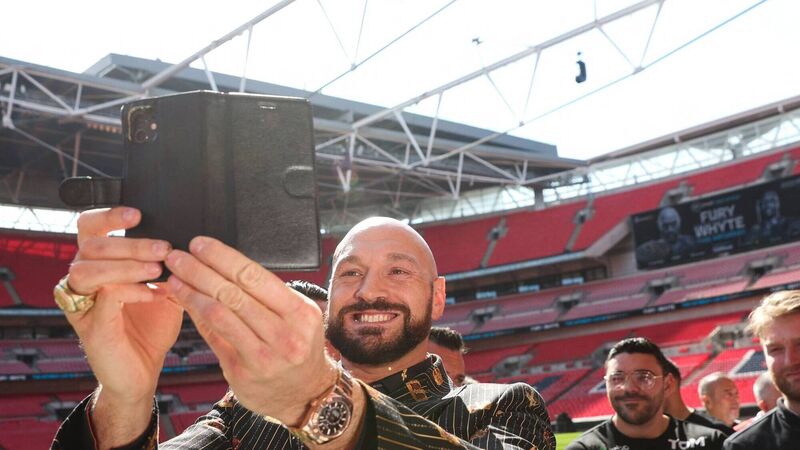Paul Rouse: Boxing will always survive but boxers need a survival guide

World Boxing Council (WBC) heavyweight title holder Britain's Tyson Fury takes part a selfie picture with a mobile phone during a tour of the Wembley Stadium pitch as part of a pre-fight press conference, in west London, on April 20, 2022. - Tyson Fury is set to have his first bout on home soil in nearly four years when he defends his World Boxing Council (WBC) heavyweight title in an all-British clash against Dillian Whyte at Wembley Stadium on April 23. (Photo by Adrian DENNIS / AFP) (Photo by ADRIAN DENNIS/AFP via Getty Images)
All week the drums have been beating for this weekend’s world heavyweight title fight between Tyson Fury and Dillian Whyte.
The drums have to beat because there are pay-per-view tickets that must be sold.
And they will be sold in their millions. The lure of boxing is undeniable. People are drawn to the spectacle of watching men (and increasingly women) hitting each other with their fists. They are drawn, also, to the qualities of bravery and resilience, as well as the skill and intelligence, of the greatest fighters.
Subscriptions from across the globe will mean earnings of tens of millions of dollars to be shared between boxers, trainers, seconds, hangers-on, promoters, media companies and the many, many others with their snouts in the bounteous trough of professional boxing.
What follows next will be dismissed as irritating killjoy pearl-clutching, but it is also undeniable truth: the price that will be paid by Fury and Whyte for providing this spectacle promises to be horrific.
A professional fighter might take 40,000 hits to the head in the course of their boxing life.
What happens with this hit to the head is that when the “soft mass of nerves and blood vessels that float in a bowl of fluid we call the brain is jarred against the skull, it is permanently damaged.”
And when that happens over and over again, the reality is often long-term and involves a profound deterioration in capacity that is observable in many fighters. All serious research in the area supports this view.
For example, Charles Bernick has studied 224 fighters (131 mixed martial arts fighters and 93 boxers) in a recent “Professional Fighters Brain Health Study”.
Participants in the study were given a baseline evaluation and were then evaluated on an annual basis over the following four years. This was among fighters still involved in the sport, not those reaping a later-life dividend of their younger days. Basically, the study showed diminished brain volume and diminished processing speed. It ended with the conclusion that “repetitive head trauma” meant a “greater likelihood of having cognitive impairment.” Bernick’s study is a relatively new one, but there is nothing new about medical evidence of the damage that boxing does to the brain.
A brilliant article by Robert Colls in last September noted: “We have known about the consequences of professional boxing for at least a hundred years – blurred vision, slurred speech, mood swings and so on. In 1928 the American pathologist Harrison Martland called it 'punch drunk'.
"Nowadays neurologists call it chronic traumatic encephalopathy, and link it to early dementia and Parkinson’s disease. Few are spared. Even the greatest and most skilful fighters have shuffled their way towards boxing’s final judgement — Joe Louis, Sugar Ray Robinson, Floyd Patterson, and even Muhammad Ali.”
Colls was writing in the context of a devastating book, Tris Dixon’s , which was published in 2021.
Dixon was writing about the history in boxing of chronic traumatic encephalopathy (CTE), a brain condition caused by repeated blows to the head.
What makes Dixon’s book so powerful is the empathy – even love – that he demonstrates for boxers. He is an insider in the sport and was for many years the editor of ‘Boxing News’. He also presents a superb podcast called ‘Boxing Life Stories’. This is an unparalleled collection of interviews with boxers and what shines through them is the esteem that Dixon displays for the people he writes about. This esteem is rooted in the knowledge that they risk their lives every time they climb through the ropes.
His book ‘Damage’ has been described by people intimately involved with fighting as “the most important book the fight game has ever seen.” It is not difficult to understand why. It is unfaltering in the way that it draws on the stories of boxers and their families to lay bare the reality of the impact of taking punches. Testimony is piled upon testimony, but not in a way that is either mawkish or repetitive. Instead, it is utterly compelling.
It is possible to read the book in an extractive way and see in it a formidable case for why boxing should be immediately banned. But, as Dixon’s successor as editor of ‘Boxing News’ has written: “I’d suggest that if you’re involved in boxing and you haven’t had at least one moment where you seriously struggle to justify your love for the sport then you shouldn’t be here. Those without consciences are the worst kind of people in our sport, no question. But Dixon is quite the opposite of that. What he has created is not a book that should see the sport outlawed, but a survival guide for all within it.”
This survival guide is difficult to condense into a paragraph or two, but it involves a call for a fundamental reassessment of the habits of fighters and the processes by which they are trained.
For example, the amount of sparring done by boxers involves needless headshots that are potentially devastating individually and, taken collectively, are invariably harmful.
On top of that, there is much work to be done around concussion, around substance abuse, and around the structural organisation of boxing.
And this is where we get right down to the crucial challenges in the regulation of boxing. The essential truth is that professional boxing is not regulated by a governing body which can set basic standards of what is acceptable.
Instead, championship bouts and world titles are awarded by the World Boxing Association (WBA), World Boxing Council (WBC), International Boxing Federation (IBF), World Boxing Organization (WBO) and The Ring magazine.
Education and accountability inevitably suffers in that alphabet soup of competing bodies. It means setting basic standards of behaviour has proven impossible. For example, even across American states – let alone across the rest of world – there is no standard medical test that a boxer must undertake before fighting. More than than, a boxer who is barred from boxing for medical reasons in one place can end up being accepted to fight in another.
The great problem is that is not obvious how this can change. How do you unify the sport of professional boxing under one organisation? This question has remained unsuccessfully answered decade after decade.
It is as if the sport of boxing has aspects of the modern sporting revolution but retains also the traditions of fighting which extend back across centuries.
This is the tradition of prizefighting which draws on Dan Donnelly and John Heenan and other men who fought each other in country fields in front of huge crowds. Amid the blood and chaos, people gambled and drank and enjoyed themselves. It was wild and wildly popular.
Robert Colls has written how towards the end of the 19th century the “violence and corruption obliged prizefighting to reinvent itself as a respectable modern sport” and that “spiked boots, muddy fields, bare knuckles and shady deals were out, and canvas rings, bright lights, Queensberry Rules and shady deals were in.”
And this is true. But something of the old tradition was never entirely lost. Instead, it remade itself and boxing has never fully adopted the modern way of organising sport.
This will be revealed again on Saturday night when Whyte and Fury step into the ring. They sit at the apex of a sport that is both modern and pre-modern; it is also a sport whose dark lure ensures it is embedded in popular culture.
The essence of its grip through century after century can be seen in its cultural representations. Mesopotamian stone reliefs from the fourth millennium BC provide the first visual representation of men fighting and this is an image that has been captured again and again, in society after society, in pottery and painting, in poetry, novels and cartoons, on film and in song.
When something survives that long in so many different places – always evolving, shifting in meaning and in forms of organisation – there can be no denying its importance. This importance may wax and wane, may be contested, may be threatened, but it is real and indicates that boxing will always find a way to survive and even prosper.
There is a final reason why this is the case. Perhaps the brilliant light heavyweight boxer Roy Jones Jr put it best when he said simply: “If it made money, it made sense.”








